Event staff scheduling software takes the chaos out of coordinating your team, so your events run smoother, and your staff know where to be and when.
Managing staff across multiple events, shifts, and last-minute changes can overwhelm even the most experienced planners.
The right scheduling software keeps everyone on the same page, saves time, and helps avoid no-shows.
In this article, I compare the 5 best tools for scheduling event staff, including:
Our Top Picks
-
1
Best for all-in-one scheduling & communication
-
2

Good for agile shift management in small/mid teams
-
3
Good for compliance & labor analytics
Why trust us?
Our team of unbiased software reviewers follows strict editorial guidelines, and our methodology is clear and open to everyone.
See our complete methodology
How I Chose the Best Event Staff Scheduling Software
There are so many different types of event staff schedule software, so I narrowed down the best based on these key features:
Must-have features
- Real-time shift updates: You should be able to quickly adjust schedules and alert staff immediately, since things rarely go exactly as planned.
- Mobile access: Staff need to be able to check schedules, clock in, or get updates on the go, so a strong mobile app was non-negotiable.
- Smart scheduling: You can build schedules automatically based on staff availability, specific skills, or roles to save you time and minimize issues.
- Built-in communication: You can send shift reminders or last-minute changes to keep everyone in the loop without switching between multiple platforms.
- Availability tracking: Staff can set their availability in advance, so you’re not chasing people down for every shift.
I also made sure the software is:
- Fast to set up and scale, so you can onboard new staff quickly—even right before an event.
- Flexible across event types for a multi-day festival, a one-off gig, or rotating venue crews.
- Easy for staff to use even if they’ve never used scheduling software before.
Finally, I checked for features that make event staff scheduling software great:
- Geofencing: Monitors staff location and logs their time accurately.
- Shift confirmation and reminders: Allows you to know who’s seen their schedule.
- Custom roles and permissions: Team leads or on-site managers can make updates without giving everyone full admin access.
- Checklists: Helps ensure staff follow key steps before, during, or after an event—like setup tasks, safety checks, or teardown procedures.
The 5 Best Event Staff Scheduling Softwares of 2025
-
Connecteam — Best for all-in-one scheduling & communication
Connecteam is an all-in-one employee management solution designed to streamline staff scheduling, team communication, and task management.
Why I chose Connecteam: Connecteam makes complex event staff scheduling easy. Built with both admins and users in mind, Connecteam has great mobile and desktop interfaces. I like how precise you can be with assigning shifts based on availability, preference, and skill level, plus the auto-scheduling feature, which does the hard work for you.
Here’s what else Connecteam can do for you:
Seamless AI scheduling
Connecteam’s drag-and-drop scheduler makes creating and adjusting schedules quick and easy.
But what really impressed me was Connecteam’s AI scheduler. It makes scheduling event staff faster than I could have imagined. What’s great is the features automatically assigns shifts based on staff availability, qualifications, and time-off requests, which saves you hours of manual planning. This means that every shift is filled with the right person, and you have coverage for peak times or last minute changes.
Connecteam also balances shift distribution fairly, which helps prevent overworking or understaffing. It also keeps compliance in check by respecting work regulations, like shift limits and overtime.
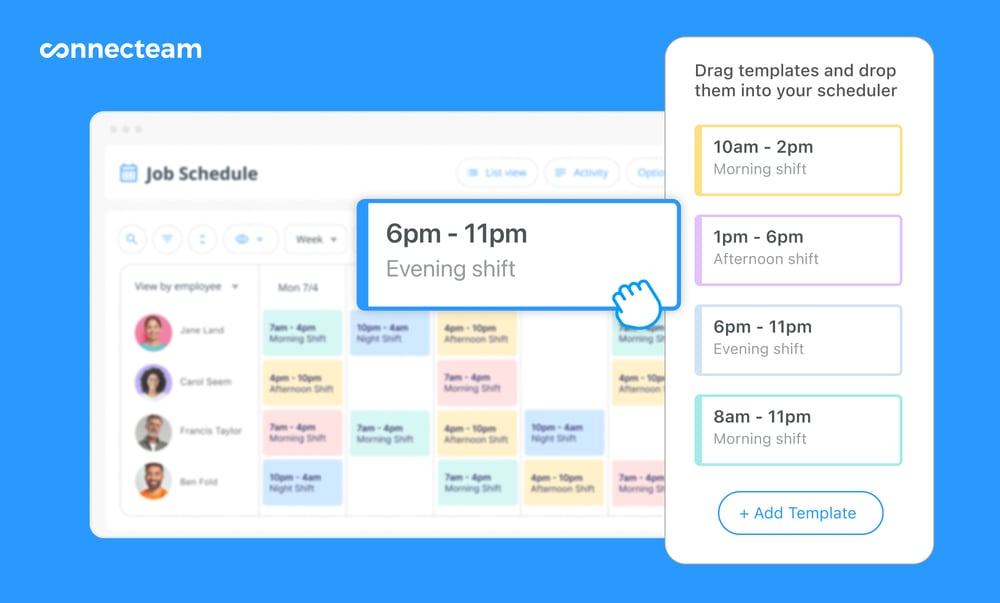
Find shift replacements, fast
I also liked how Connecteam handles shift replacements. If someone calls out or needs to swap a shift, you don’t need to scramble. Instead, users can find their own shift replacements by releasing their shift and letting other qualified teammates claim it. You can set up admin approval to make sure that all replacement requests are reviewed before being finalized. The system notifies both the original and replacement staff to keep everyone informed and reduce the chances of confusion or missed shifts.
Communicate with your team on the go
For events, Connecteam’s work chat keeps your team connected without having to manage personal contact details. The instant messaging and group chats feel intuitive, like you’re using any other messaging app. But the bonus is that you can send updates, share schedules, or handle last-minute changes, all without leaving the Connecteam app.
Staff members don’t need to save your contact information to communicate. Because everything is handled directly through the app, it’s a great fit for event teams with short-term or temporary staff.
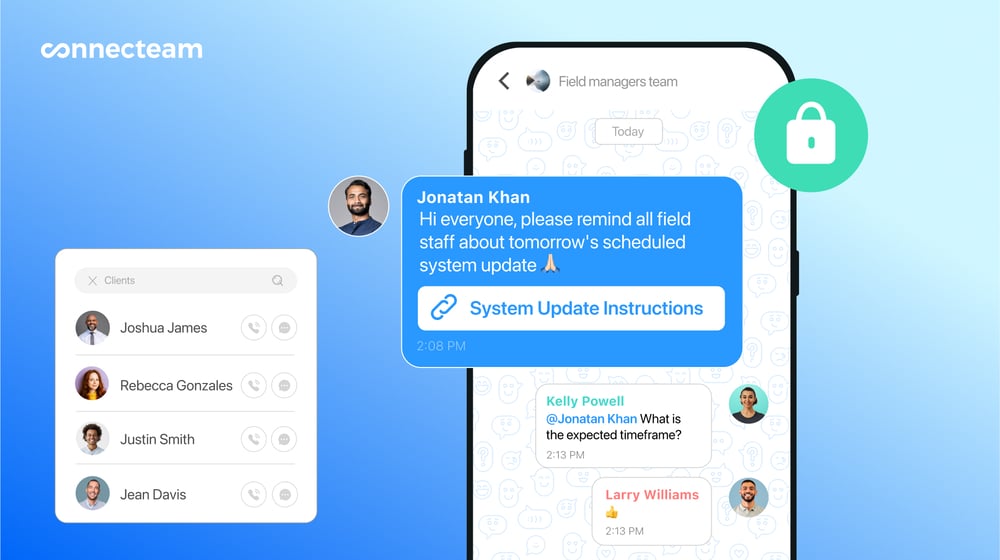
Geofencing & GPS time clock
Connecteam’s time clock has geofencing and GPS tracking capabilities that make it simple to track your staff’s hours and location. By setting up a custom work zone, you can restrict staff clock-ins to the event space and automatically clock them out when they leave the area.
It’s easy to create multiple geofenced areas for different event locations and adjust the size and hours to fit your needs. I liked how you can get real-time visibility over field attendance and stay on top of who’s working where, without having to micromanage. You can also get alerts for early clock-ins or missed check-ins.
I also found it really helpful that the time clock is accessible on the mobile app, which could speed up the check-in process for a large staff. It would make it easy for everyone to clock in on time, at the same time.
Plus, the time clock automatically records staff hours on digital timesheets, which you can integrate with your payroll software, to make payroll processing that much easier.
Speaking of integrations…
Connecteam offers a great range of integrations, including:
And much more…
Connecteam offers more than just a powerful scheduler, accurate time clock, and intuitive team chat. You can create custom checklists and forms to speed up processes, keeping everything organized in one place. Plus, Connecteam lets you store and manage employee documents directly within the app, so you always have what you need at your fingertips.
Key Features
- AI scheduler
- GPS time clock
- Shift swapping
- Geofencing
- In-app chat with groups
- Checklists and forms
Pros
- Real-time visibility and updates
- Mobile-friendly design
- Intuitive and easy to use
- All-in-one solution
Cons
- Needs internet or WiFi access to work
Pricing
Free-for-life plan availablePremium plans start at $29/month for 30 users
14-day free trial, no credit card required
Start your free trial -

Deputy — Good for agile shift management in small/mid teams
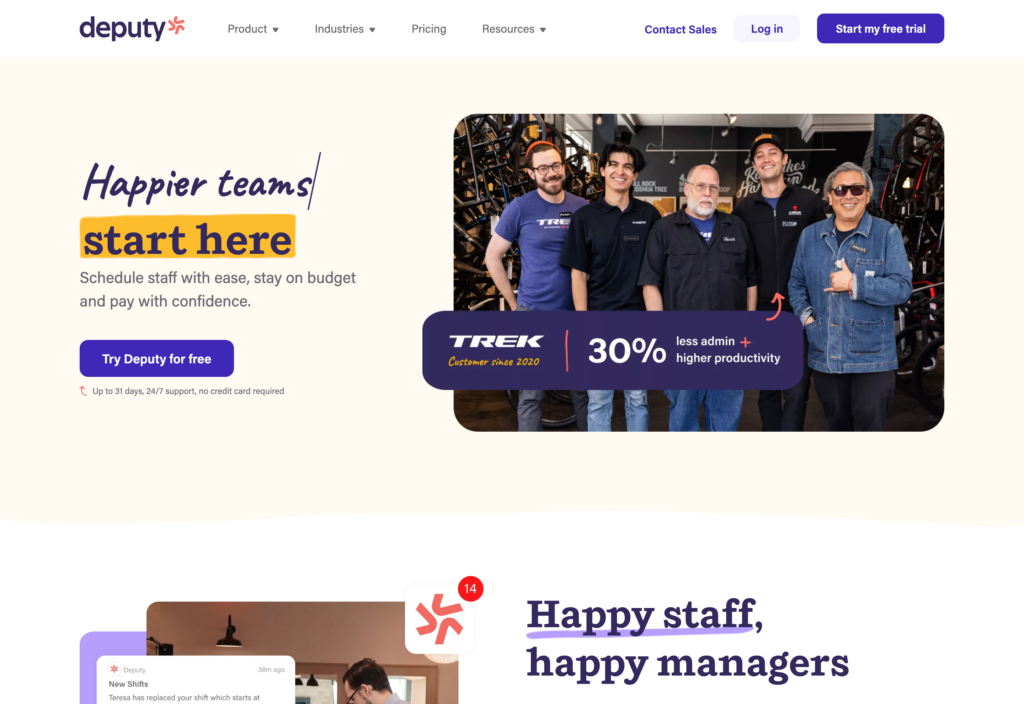
Deputy is a workforce management platform that offers scheduling, time tracking, and communication. It’s a good fit for businesses that need detailed shift scheduling and accurate time tracking.
Why I chose Deputy: I liked how Deputy’s AI-powered auto-scheduling and geofencing capabilities make it easy to manage shifts. Its leave management system is great for keeping track of staff availability.
Scheduling for teams
One of the features that caught my attention with Deputy was its drag-and-drop scheduling tool. It makes it easy to quickly assign shifts and make changes. The auto-scheduler also helps by automatically assigning shifts to employees based on availability, qualifications, and your labor budget.

Deputy’s scheduler gives a clear overview of your staff and their scheduled work times. Staff can claim open shifts, and you set specific rules for shift lengths and start times.
The main downside I found was that the scheduling tool on the mobile app was a bit challenging to navigate. The layout was confusing and not as intuitive as I hoped.
Time tracking
I liked how flexible Deputy’s time tracking was—you can let staff clock in and out using mobile devices or a shared kiosk. With geofencing, you can also make sure that staff only clocks in when they’re within the designated area, like at the event site.
For added security, I appreciated Deputy’s use of biometric facial recognition or photo capture at shared kiosks. When a team member clocks out, they have the option to leave a shift feedback note. It’s an interesting idea, but I couldn’t find a way to flag a note as important for emergency or urgent situations.
Timesheets are automatically generated from clock-ins and show both hours worked and wages, including overtime or premium rates.
Newsfeed communication
Deputy has a newsfeed tool to enhance internal communication. This feature allows managers to post messages to individuals or specific locations so that staff can receive important updates.
I liked that you could add PDFs, images, and videos to newsfeed posts for easy sharing and viewing. You can also allow staff to react to messages with emojis or confirm they’ve read updates.
While the newsfeed is useful for keeping teams aligned, you can’t send messages to custom groups. It also doesn’t feel like a traditional messaging app. Even one-on-one conversations appear in the same public feed, which I would find hard to adjust to for private use.
What users say about Deputy
It is easy for us to setup schedules but also equally easy for our workers to set their unavailability for our scheduling.
The customer support from Deputy is honestly some of the worst I’ve ever encountered. Everything is chat/email based, you can’t get anyone on the phone and their entire support function is offshored
What’s new with Deputy
Deputy recently raised its base price from $4.50 per user/month to $5 per user/month. Existing clients are now being moved to the new pricing, significantly raising costs for many.
Key Features
- Staff scheduling
- Newsfeed communication
- Geofencing
- Time tracking
Pros
- AI-powered auto-scheduler
- Biometric facial recognition
Cons
- Doesn’t work offline
- Advanced features only available on Enterprise plan
Pricing
Starts at $5/user/month Trial: Yes — 31 days Free Plan: No
-
Humanity by TCP Software — Good for compliance & labor analytics
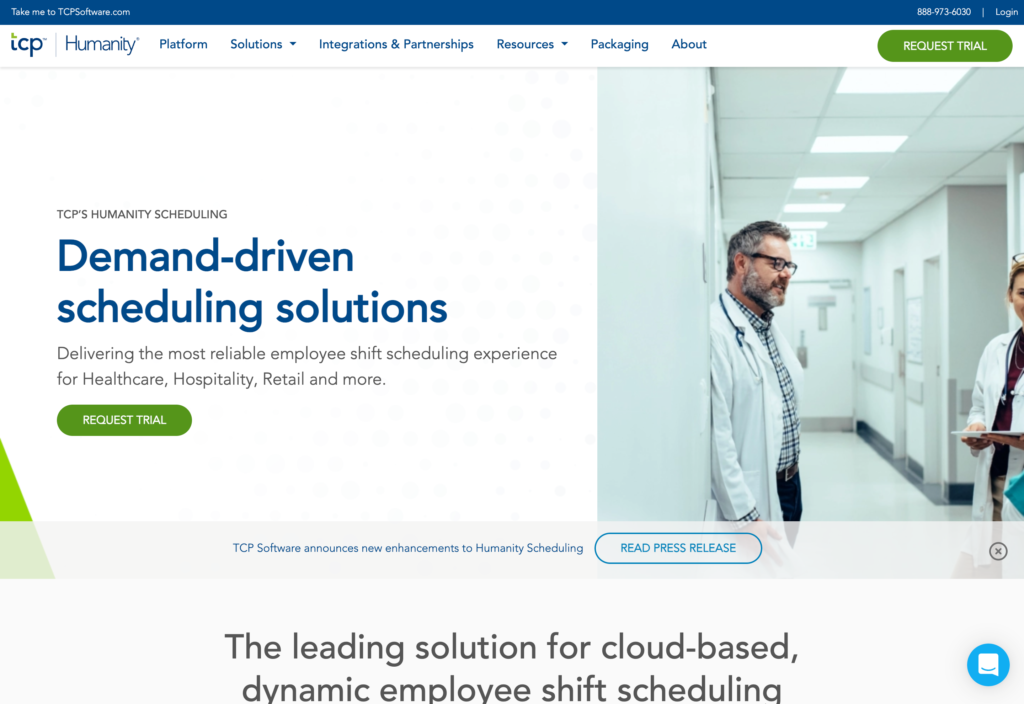
Humanity is a feature-rich scheduling platform built for businesses that need to stay on top of compliance—but it might not suit everyone.
Why I chose Humanity: When I tested Humanity, I appreciated its strong compliance focus and AI-powered scheduling (although the forecasting feature costs extra). The pre-built compliance rules made it easier to stay aligned with labor laws without manually setting everything up.
Scheduling and shift management
I found scheduling with Humanity pretty flexible. You can build shifts using templates, copy past schedules, or auto-schedule based on employee skills, availability, and time-off requests. I liked that employees can also self-assign open shifts and swap shifts with each other, with manager approval.
You and your team can access schedules through desktop, mobile devices, tablets, and even Apple Watches, which I found convenient. Just a heads-up: the pre-built compliance rules are only set up for the US, so if you’re outside the US, you’ll have to configure your own.
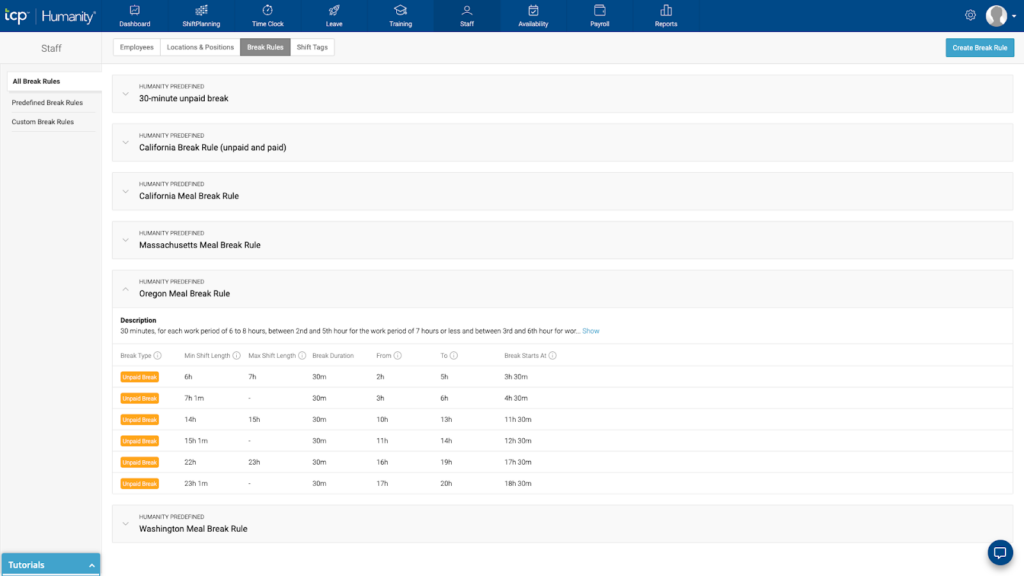
Humanity offers pre-built scheduling rules, and users can make their own rules to create compliant schedules. Time tracking and payroll
The time clock was intuitive to use. I liked how it automatically flagged late check-ins, making it easy to spot issues. Creating timesheets from the time clock data was straightforward, and I appreciated that you can either manually approve timesheets or set up auto-approval rules to speed things up. Plus, Humanity integrates with more than 30 payroll providers, which makes processing payroll much easier.
Communication tools
Humanity includes email, SMS, push notifications, an in-app chat, and a message board. These tools worked well during my testing, but I did feel that the communication features felt a bit outdated compared to newer platforms.
Where Humanity falls short
While I was impressed by Humanity’s scheduling and compliance tools, the platform felt overwhelming at times, especially if you just need a simple scheduling solution. There’s no free plan available, and the pricing isn’t listed publicly—you’ll have to reach out for a quote. That could make it harder to predict costs, especially for smaller teams.
On the plus side, I found Humanity’s 24/7 customer support responsive and helpful, which definitely made it easier to get up to speed with the platform.
What users say about Humanity
I love the simplicity of having control of my schedule right at my fingertips. It is so nice to be able to pick up schedules and drop them quickly when needed.
I wish it loaded a little faster, and took the shifts away that I can’t schedule. Sometimes the shifts are still up even when I am not allowed to schedule them.
Key Features
- Shift planning
- Compliance rules
- Time clock
- Payroll integrations
Pros
- Offers auto scheduling
- Supports US compliance laws
Cons
- Pricing isn’t publicly available
- No free plan
Pricing
Contact vendor for price Trial: Yes Free Plan: No
-

Shiftboard ScheduleFlex — Good for service-centered organizations

Shiftboard offers flexible scheduling for medium-sized businesses, but its clunky interface holds it back.
Why I chose Shiftboard: When I tested Shiftboard, I liked how easy it was to build schedules and how many options it offered. You can auto-schedule shifts, assign them based on employee qualifications, and use a tradeboard so employees can swap shifts with manager approval.
Flexible scheduling
Shiftboard works well if you need to schedule across multiple teams or locations. I appreciated that it can automatically create schedules based on labor demand, and that you can import employee qualification data from your HR software to speed things up.
That said, I was frustrated that Shiftboard doesn’t support drag-and-drop scheduling. Editing or moving shifts requires several clicks, which felt unnecessarily clunky.
What really stood out to me was how easy it is to handle open shifts. Employees can volunteer for unclaimed shifts through a sign-up list, and the tradeboard system lets employees offer their shifts for others to pick up after manager approval.
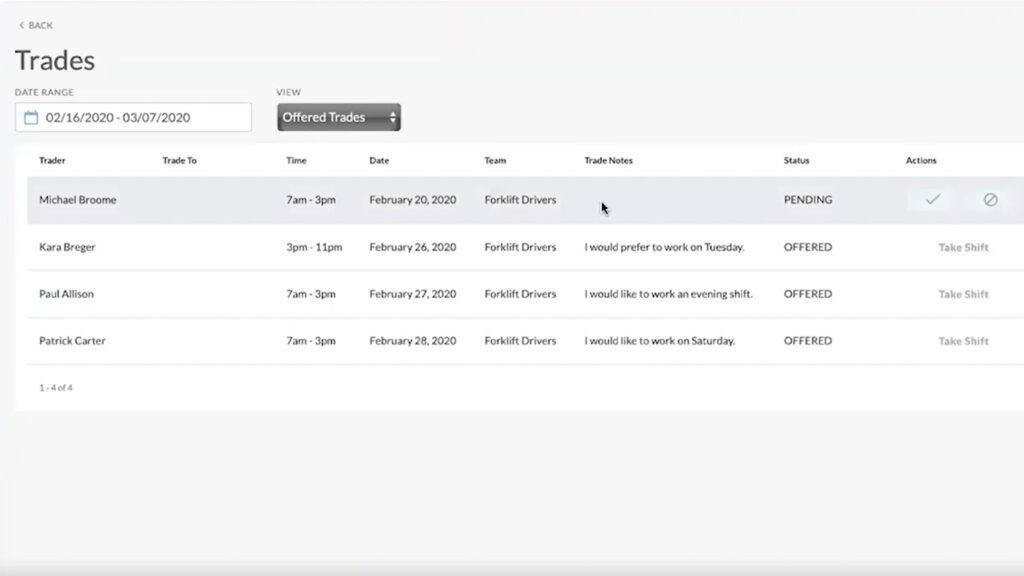
Shiftboard lets your employees trade their shifts with ease. Time tracking and timesheets
Shiftboard’s time clock lets employees clock in and out from mobile or desktop apps, and their locations are recorded at the start and end of shifts. However, I didn’t like that there’s no GPS tracking during the shift and no geofencing to prevent off-site clock-ins.
The timesheet system was also basic. It accurately logs time, but there’s no way to track different pay rates for different shifts or let employees review their own hours.
Communication tools
Shiftboard’s built-in messaging feature lets managers send updates to employees and target messages by team or assignment. I liked the targeting options, but the lack of two-way communication felt limiting—employees can’t reply to messages or chat with each other, which reduces the messaging tool’s usefulness.
Where Shiftboard falls short
While Shiftboard covers the basics of scheduling and time tracking, it doesn’t offer much beyond that. There’s no free plan, and pricing isn’t transparent—you’ll need to contact the sales team and have at least 100 employees to qualify.
I also found the web interface very outdated, mostly black, white, and gray, which made it harder for me to focus during longer sessions. The mobile app is a lot better, but overall, Shiftboard’s software feels stuck a few steps behind more modern alternatives.
What users say about Shiftboard
It is very particular in its functionalities—if any step (even as small as checking an optional box) is missed or incorrect in any given process, the entire schedule will be off, and you won’t know until you finish and look at the calendar.
Very good features for bulk assignments and automated help generating a schedule. (Good for large organizations or new sites needing a schedule generated.)
Key Features
- Staff scheduling
- Time clock with timesheets
- Team messaging
Pros
- Easy to use with flexible scheduling options
- Auto-scheduler available
Cons
- Interface feels clunky and outdated
- Lacks drag-and-drop for fast shift edits
Pricing
Contact vendor for price Trial: No Free Plan: No
-

Planday — Good for small teams and integrations
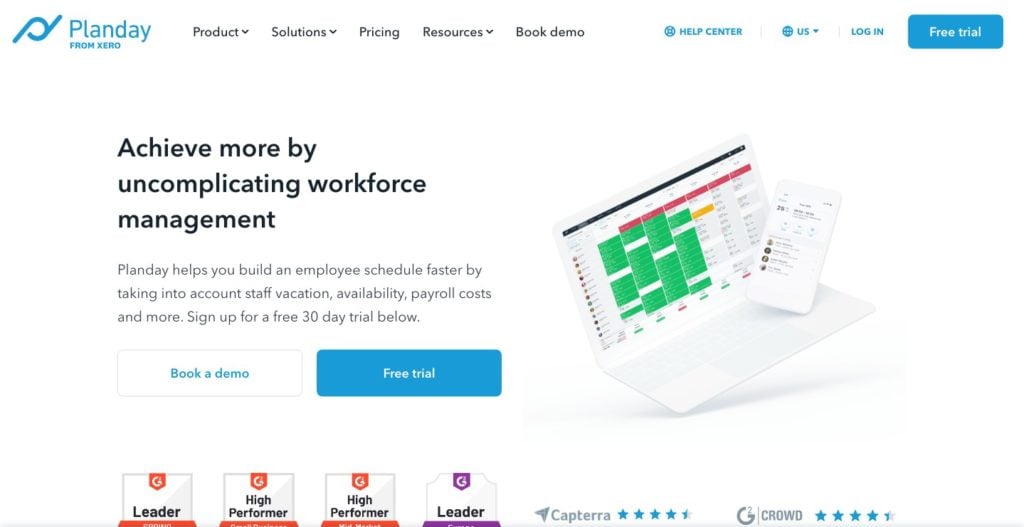
Planday is a team scheduling and time tracking platform built for small, location-based teams, offering a clean and easy-to-use experience.
Why I chose Planday: When I tested Planday, I really liked the clean and intuitive interface. It was easy to create shifts, approve time, manage availability, and navigate between features without a steep learning curve. The wide range of integrations—especially for payroll and point-of-sale systems—was another standout.
Quick shift planning
Creating shifts with Planday was fast and straightforward. I could drag and copy shifts across the calendar and assign them in just a few clicks. It was also easy to see who was working and make quick edits on the mobile app.
One thing that surprised me was the lack of a recurring shift option, which added more manual work than I expected. Planday does offer auto-scheduling, but it’s only available on the Pro plan, which could get pricey if you’re on a tighter budget.

You can edit your scheduling view to add or remove details, such as revenue streams. Simple time tracking with GPS
Planday’s built-in time clock was easy for staff to use. Employees can clock in and out through the mobile app, with GPS location logged at each clock-in. I also liked that you can set up a geofence to limit clock-ins to specific sites.
However, I found it frustrating that Planday doesn’t generate payroll-ready timesheets. You can create reports based on individual work hours, but they take some time to produce and don’t look like traditional timesheets.
Communication and integrations
Planday’s communication tools let you send messages to individuals or teams, check who’s read them, and even “require” a reply. That said, the messaging system felt more like email than real-time chat, and announcements posted to dashboards are one-way only—there’s no option for employees to respond or interact.
I appreciated Planday’s strong integration library, which includes payroll, POS, and tipping platforms. If you’re tracking labor costs against real-time revenue, the POS integrations are especially helpful.
Where Planday falls short
While Planday is intuitive and affordable, its limited reporting capabilities and lack of payroll-ready timesheets could create extra work as your team grows. Mobile functionality is also thinner for admins compared to the desktop version.
What users say about Planday
It helps to see all the shifts together in one place for all employees. its easy to schedule check and change shifts between colleagues as well. I use weekly to change and check the shifts.
The mobile app has long loading times. Our employees have iPhones and are used to swifting through mobile mobile apps with high speed. But this app sometimes loads 30 seconds, even 45 seconds while opening the app.
Key Features
- GPS time tracking
- Employee messaging
- Drag-and-drop scheduler
- Time off management
Pros
- Easy-to-use interface
- Large range of integrations
Cons
- No automated timesheets
- No recurring shifts
Pricing
Starts at 2.99€/month Trial: Yes — 30-day Free Plan: No
Compare the Best Event Staff Scheduling Softwares
| Topic |
 Start for free
Start for free
|

|
|

|

|
|---|---|---|---|---|---|
| Reviews |
4.8
|
4.6
|
4.3
|
4.4
|
4.3
|
| Pricing |
Starts at just $29/month for the first 30 users
|
Starts at $5/user/month
|
Contact vendor for price
|
Contact vendor for price
|
Starts at 2.99€/month
|
| Free Trial |
yes
14-day
|
yes
31 days
|
yes
|
no
|
yes
30-day
|
| Free Plan |
yes
Free Up to 10 users
|
no
|
no
|
no
|
no
|
| Use cases |
Best for all-in-one scheduling & communication
|
Good for agile shift management in small/mid teams
|
Good for compliance & labor analytics
|
Good for service-centered organizations
|
Good for small teams and integrations
|
| Available on |
What is Event Staff Scheduling Software?
Event staff scheduling software helps organizers plan, assign, and manage work shifts for staff working at events. Whether it’s a conference, concert, festival, or corporate function, this software makes it easier to coordinate roles, track availability, and ensure every shift is covered—without relying on spreadsheets or group texts.
These platforms typically include features like drag-and-drop scheduling, automated shift assignments, time tracking, and real-time communication tools. They’re designed to streamline staffing logistics, reduce no-shows, and improve team coordination. This software is especially useful for events with large crews, rotating staff, or last-minute changes.
How Does Event Staff Scheduling Software Work?
Event staff scheduling software works by bringing all the tasks involved in planning, assigning, and managing event shifts into one easy-to-use platform. Managers can create schedules from scratch or use templates, then assign staff based on their availability, roles, or qualifications. Most tools make this easy with features like drag-and-drop scheduling or auto-fill options that match staff to open shifts automatically.
Once shifts are published, the software notifies team members through email, app alerts, or text. Staff can then confirm, request changes, or swap shifts—depending on what the manager allows. On the day of the event, many tools also include GPS-enabled time clocks, so staff can check in and out from their phones at the right location.
Most of these tools also make it easy to track availability, time-off requests, and total hours worked. Plus, all changes are updated in real time, so staff will know instantly.
The Benefits of Event Staff Scheduling Software
Shift planning software helps you manage shift scheduling more efficiently. Some of the other benefits include:
Make instant changes
Events often change minute to minute. Real-time schedule updates let you adjust things on the fly and instantly notify staff, so you can avoid confusion, reduce no-shows, and keep everything moving smoothly.
Accessible anywhere
A strong mobile app lets staff check their shifts, clock in, and get updates no matter where they are. This can also help teams stay connected on-site and cut down on missed messages or miscommunication.
Save time
Automated scheduling tools match staff to shifts based on their availability, skills, or roles. This reduces the time you spend building schedules and makes it easier to avoid double-booking or undercoverage.
Keep communication clear
Built-in messaging keeps shift-related conversations in one place. Instead of jumping between apps, you can send reminders, updates, or last-minute changes directly through the platform.
No back and forth
When staff enter their availability ahead of time, you can fill shifts faster and skip the guesswork and the hassle of chasing people down.
How Much Does Event Staff Scheduling Software Cost?
Most event staff scheduling software charge a monthly fee per user. Prices usually range from $2-$10 per user/month, depending on the features you need. Some platforms also charge extra for additional features. The most affordable shift planning tools offer free plans and flat-rate pricing models. For example, Connecteam’s Small Business Plan is completely free for up to 10 users. You get access to all paid features forever. Paid pricing starts at $29/month for 30 users, which is less than $1 per employee.
FAQs
Connecteam is the best free option. Its Small Business Plan is 100% free for up to 10 users and includes scheduling, time tracking, and built-in communication—perfect for small event teams.
Automated scheduling tools assign shifts based on staff availability, roles, or skills. With Connecteam, you can auto-fill open shifts and let qualified team members claim them, saving hours of manual planning.
If you manage shifting schedules, multiple team members, or last-minute changes, then event staff scheduling software can save you time, reduce no-shows, and keep everyone on the same page. It’s especially useful for events with rotating crews or tight timelines.
The Bottom Line on Event Staff Scheduling Software
Event staff scheduling software is a great way to handle last-minute changes, build schedules faster, and keep everyone in the loop. The right tool can solve all of that—and make your events run smoother from start to finish.
I reviewed several top platforms built to support event teams of all sizes and needs, but Connecteam stands out as the best overall choice. Connecteam combines ease of use with powerful features built specifically for fast-paced, on-the-ground teams. You can build and adjust schedules in minutes, send real-time updates, track hours with GPS, and manage staff communication—all from one app.
What really sets it apart is its flexibility. Whether you’re managing a one-night gig or a multi-day festival, Connecteam scales with you. And with a 100% free plan for up to 10 users, it’s one of the few tools that delivers serious value without a steep price tag.




